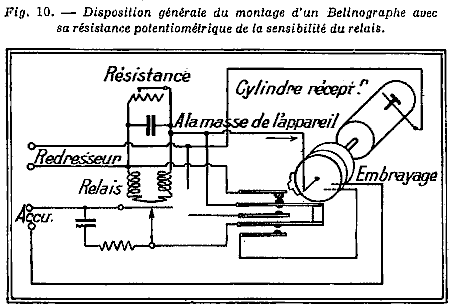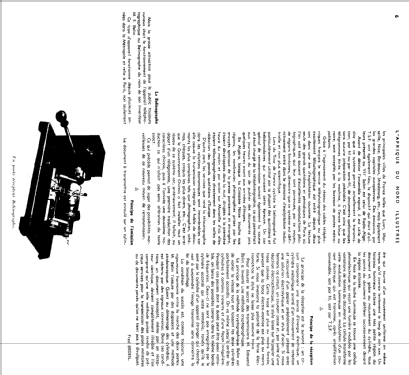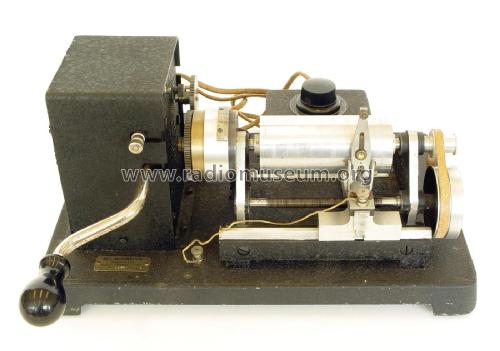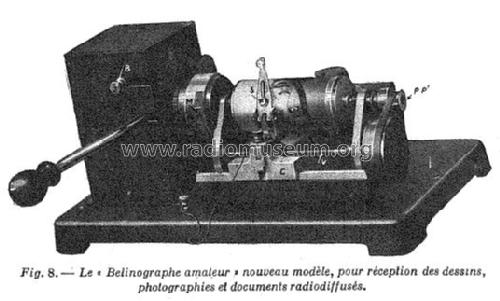Bélinographe pour amateurs BEL1
Belin, Édouard (Télétype); Paris, Rueil-Malmaison
- País
- Francia
- Fabricante / Marca
- Belin, Édouard (Télétype); Paris, Rueil-Malmaison
- Año
- 1927 ??
- Categoría
- Miscelanea, objetos de propaganda, pines, banderines, ceniceros, otros, etc.
- Radiomuseum.org ID
- 132639
Haga clic en la miniatura esquemática para solicitarlo como documento gratuito.
- Gama de ondas
- - no hay
- Tensión de funcionamiento
- Otros, detailles desconocidos.
- Altavoz
- - - No hay salida de sonido.
- Material
- Metálico
- de Radiomuseum.org
- Modelo: Bélinographe pour amateurs BEL1 - Belin, Édouard Télétype; Paris
- Forma
- Sobremesa de cualquier forma, detalles no conocidos.
- Anotaciones
-
The model B.E.L.1 presented here is only a reproducer at the receiving end of the wire or wireless. It still needs a wire or wireless receiver and a rectifying amplifier.
A crank operated spring mechanism drives the cylinder with constant speed. A synchronising pulse is expected at the beginning of every revolution to start the cylinder.For a more detailed explanation of the principle, please read the article below.
More details on the needed chemical solution can be found in the literature mentioned on this page. Attention: explosion- or health hazard when manipulating chemicals!
Le Bélinographe B.E.L.1 pour amateurs est un appareil de reproduction seulement, prévu à l'utilisation après un récepteur par fil/ sans fil et un amplificateur-redresseur.
Un mécanisme à ressort, actionné par manivelle, fait tourner le cylindre à vitesse constante. Une impulsion synchronisante est nécessaire au début de chaque tour du cylindre.Vous trouverez un article avec explication détaillée du principe en dessous de cette page.Plus d'informations sur la solution chimique nécessaire se trouvent dans la littérature mentionnée sur cette page. ATTENTION : risque d'explosion ou de la santé lors de la manipulation de produits chimiques !
- Mencionado en
- La Nature, 1929, 2ème, p.467-470
- Documentación / Esquemas (1)
- La Nature, 1930, 2ème, p.184-185
- Autor
- Modelo creado por un miembro de A. Ver en "Modificar Ficha" los participantes posteriores.
- Otros modelos
-
Donde encontrará 3 modelos, 3 con imágenes y 2 con esquemas.
Ir al listado general de Belin, Édouard (Télétype); Paris, Rueil-Malmaison
Colecciones
El modelo Bélinographe pour amateurs es parte de las colecciones de los siguientes miembros.
Contribuciones en el Foro acerca de este modelo: Belin, Édouard: Bélinographe pour amateurs BEL1
Hilos: 2 | Mensajes: 2
- For amateur or primitive systems, electrochemical processes were in use. The paper has to be impregnated with a chemical solution in order get a color change by the electrolytic effect on the spot where the electrical current passes, where the color change is proportional to the current intensity. This effect only works when the current always flows in the same direction, hence the need for a rectifying amplifier between the wire/wireless receiver and the image reproducer. More details on the needed chemical solution can be found in the literature mentioned on this page. Attention: explosion- or health hazard when manipulating chemicals!
- For industrial systems, photographic processes with sensitized paper were used.
Dirk Bladt, 04.Jul.15
- Pour les appareils amateurs ou primitifs, on employait des procédés électro-chimiques. Le papier doit être imprégné d'une solution chimique et par le passage d'un courant électrique on obtient un changement de couleur par effet électrolytique à l'endroit où le courant passe. l'Intensité du changement de couleur est proportionnelle à l'intensité du courant. Cet effet s'obtient seulement que lorsque le courant circule toujours dans le même sens, d'où la nécessité d'un amplificateur de rectification entre le récepteur par fil/sans fil et le reproducteur d'images. Plus d'informations sur la solution chimique nécessaire se trouvent dans la littérature mentionnée sur cette page. ATTENTION : risque d'explosion ou de la santé lors de la manipulation de produits chimiques !
- Pour les systèmes industriels, on employait des procédés photographiques sur papier sensible.
Dirk Bladt, 04.Jul.15




